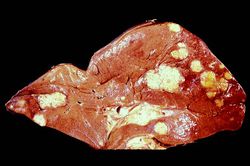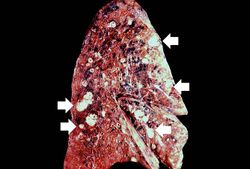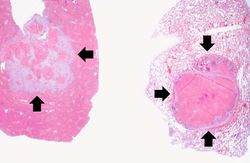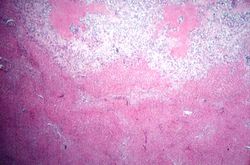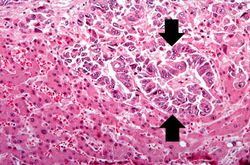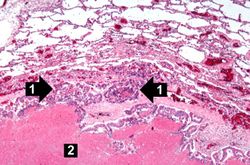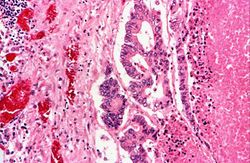Difference between revisions of "IPLab:Lab 7:Metastatic Adenocarcinoma"
Seung Park (talk | contribs) |
Seung Park (talk | contribs) |
||
| Line 21: | Line 21: | ||
* <spoiler text="What are the most common sites of metastasis for primary adenocarcinomas of the colon?">All colorectal tumors spread by direct extension into adjacent structures and by metastasis through the lymphatics and blood vessels. In order of preference, the favored sites of metastatic spread are the regional lymph nodes, liver, lungs, and bones, followed by many other sites, including the serosal membrane of the peritoneal cavity, brain, and others. Generally the disease has spread beyond the range of curative surgery in 25 to 30% of patients.</spoiler> | * <spoiler text="What are the most common sites of metastasis for primary adenocarcinomas of the colon?">All colorectal tumors spread by direct extension into adjacent structures and by metastasis through the lymphatics and blood vessels. In order of preference, the favored sites of metastatic spread are the regional lymph nodes, liver, lungs, and bones, followed by many other sites, including the serosal membrane of the peritoneal cavity, brain, and others. Generally the disease has spread beyond the range of curative surgery in 25 to 30% of patients.</spoiler> | ||
* <spoiler text="What are some clues which suggest that these are metastatic tumors rather than primary tumors?">The lesions are spread throughout both the liver and the lung and they are variably-sized. There does not appear to be a large primary tumor with multiple small "daughter tumors." Of course these only suggest metastasis. To be sure of the source of the tumor immunohistologic stains for specific diagnostic markers would be performed on the tissues to determine the tissue of origin.</spoiler> | * <spoiler text="What are some clues which suggest that these are metastatic tumors rather than primary tumors?">The lesions are spread throughout both the liver and the lung and they are variably-sized. There does not appear to be a large primary tumor with multiple small "daughter tumors." Of course these only suggest metastasis. To be sure of the source of the tumor immunohistologic stains for specific diagnostic markers would be performed on the tissues to determine the tissue of origin.</spoiler> | ||
| + | |||
| + | == Additional Resources == | ||
| + | === Reference === | ||
| + | |||
| + | |||
| + | === Journal Articles === | ||
| + | |||
| + | |||
| + | === Images === | ||
| + | |||
| + | |||
| + | == Related IPLab Cases == | ||
| + | |||
{{IPLab 7}} | {{IPLab 7}} | ||
[[Category: IPLab:Lab 7]] | [[Category: IPLab:Lab 7]] | ||
Revision as of 04:21, 23 August 2013
Contents
Clinical Summary[edit]
This 58-year-old male was admitted five weeks earlier with a weight loss of 80 pounds over a six-month period, abdominal cramps, and rebound tenderness in the right lower quadrant. Abdominal and chest x-rays showed multiple nodular radiopacities in the lungs and liver. Fine needle biopsy of the liver revealed adenocarcinoma with the primary source thought to be colon. He was discharged on chemotherapy, but returned two days later with small bowel obstruction and sepsis, and he died a few days later.
Autopsy Findings[edit]
Autopsy revealed an obstructive firm mass in the cecum with similar masses in the lungs, lymph nodes, liver and peritoneum. A large retrocecal abscess was found. Blood cultures grew Klebsiella pneumoniae and E. coli.
Images[edit]
Study Questions[edit]
Additional Resources[edit]
Reference[edit]
Journal Articles[edit]
Images[edit]
Related IPLab Cases[edit]
Nodular hyperplasia of the prostate--characterized by large discrete prostatic nodules--is a common disorder in men over 50 years of age. The nodules cause the prostate to be enlarged and to have an increased weight. The human prostate is surrounded by a restrictive capsule. These nodules cause increased pressure within the capsule which leads to constriction of the urethra as it passes through the prostate. Urethral constriction leads to retention of urine.
An abscess is a collection of pus (white blood cells) within a cavity formed by disintegrated tissue.
